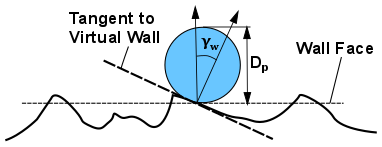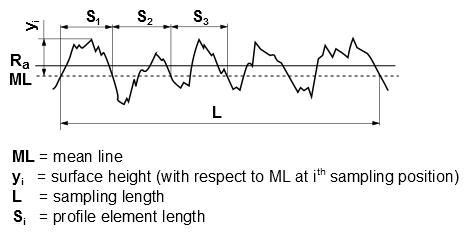The rough wall model can capture more realistic behavior of dispersed flows in confined geometries, such as cyclones and pipe systems. Studies on particle-wall interaction have shown that the motion of large or heavy particles is strongly influenced by the surface roughness.
The rough wall model used in Ansys Fluent is based on the theoretical findings in [617] and [189]. At the moment of particle-wall collision, the wall face is replaced by a face that is tangential to the virtual rough wall at the point of particle-wall contact.
The inclination angle (that is, the angle between the normal vectors of the wall face and the face
that is tangential to the virtual wall), is computed as a function of the statistical surface
roughness parameters and the current particle diameter.
Figure 12.5: Wall Roughness Parameters illustrates how the surface roughness parameters are estimated. For detailed information on statistical surface roughness parameters used in industry, see ISO 4287.
The wall roughness parameters are:
Wall mean roughness
:
Standard deviation of the roughness structure
:
Mean profile element width/spacing within a sampling length
:
where
is the number of profile elements in sampling length
.
The inclination angle is sampled from a Gaussian distribution with mean
value of 0° and a standard deviation of
.
The standard deviation of the Gaussian distributed virtual wall angle is estimated by:
(12–201) |
|
where, | |
|
| |
|
|
The model accounts for the “shadow effect” [617] in which particles cannot physically collide with a virtual wall if the angle between the particle velocity vector (prior to the collision) and the normal vector of the virtual wall is greater than π/2 rad.
Once the new virtual wall is defined by its normal vector, Equation 12–193 to Equation 12–200 are used to compute the rebound velocity of the reflected particle with respect to the virtual wall.




